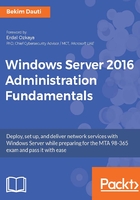
上QQ阅读APP看书,第一时间看更新
Summary
We summarize the chapter with following points:
- A computer system is comprised of the computer case, monitor, keyboard, and mouse.
- An internal device is any device that is located in the computer's case.
- An external device is any device that is attached or connected to a computer's case, and as such constitutes the whole computer system.
- A peripheral device is considered to be any device that is geographically located near to a computer, and as such is not an essential part of the computer system as a whole.
- A network device is actually a peripheral device connected to a computer by a network cable.
- A device driver is a program which acts as the translator between the computer hardware and an operating system.
- A generic driver indicates that a generic (that is, alternative) device driver is installed instead of a proper one.
- A black exclamation point on a yellow triangle next to a device indicates that either the device driver is missing, or an installed device driver is not the proper one.
- A downwards black arrow on a device indicates a disabled driver.
- In computer hardware, devices use system resources to communicate with each other.
- Plug and play work on the principle that when a device is plugged into a computer, the device is immediately recognized by the operating system.
- An IRQ, in modern computers a number from 0 to 31, is a signal sent by a device through communications channels to get the attention of a processor whenever that device requires processing.
- DMA, a number from 0 to 8, is a system resource used by a device to bypass the processor whenever that device needs access to RAM.
- Driver signing is a driver's digital signature to identify the publisher of the driver package.
- The Windows Registry is a hierarchical database that stores the hardware and software configurations, and system security information.
- HKEY_CLASSES_ROOT stores information on the installed applications and their extensions.
- HKEY_CURRENT_USER stores information on the user that is currently logged-in.
- HKEY_LOCAL_MACHINE stores information specific to the local computer.
- HKEY_USERS contains information on the logged user profiles.
- HKEY_CURRENT_CONFIG contains information gathered during the boot process.
- The services are the background programs that keep alive the Windows OS, applications and utilities.
- Automatic services start automatically when the OS starts.
- Automatic (Delayed start) services start approximately 2 minutes after all marked Automatic services have started.
- Manual services must be started either by a user or dependent services.
- Disable services cannot be started by the OS, user, or dependent services.
- Local System is the built-in account with the most privileges in a Windows OS. Known as a superuser, this account is more powerful than your admin account.
- NT Authority\LocalService is the built-in account with the same privileges as members of the Users group.
- NT Authority\NetworkService is a built-in account that has more privileges than members of the Users group.
- The service account is the Windows Server's native account or an account created by you to manage the running services.
- After setting up the device drivers and ensuring that the OS services are up and running, initial server configuration is a must.